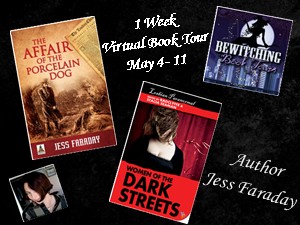By way of talking about my book, I'd
like to recommend someone else's.
Setting The Affair of the Porcelain
Dog on the back streets of late Victorian London involved more
than putting everyone in frock coats and bonnets. Creating an
accurate setting required a deep, multisensory understanding of the
city and its occupants. Toward this end, Victorian London Street
Life in Historic Photographs by John Thomson, was an invaluable
resource.
Originally published in 1877 (and
reprinted by Dover Publications in 1994), this is a collection of
original photographs by one of the world's first documentary
photographers, with accompanying explanatory text by the photographer
and writer Adolphe Smith. Having access to the images of people as
they actually appeared, and text written by people as they actually
spoke, gave me as close to an authentic time-travel experience as I
believe is possible at this point.
Perhaps because I'm part of a
generation raised more on images than on text, I found the
photographs to be essential for immersing myself in the time and
place. Seeing the clothing, the dirt, the conveyances, I could feel
them. Feeling them, I could write about them as if I had experienced
them. The accompanying texts were also helpful. Not only did I learn
what people of the time thought about, but how they thought about
them, and how they expressed those thoughts.
But even more fascinating as the
atmosphere the authors call to life are the essential parts of the
culture of the time that not only no longer exist, but which, because
of cultural and technological shifts, we would never imagine existed
in the first place. By way of example, I give you:
The Public Disinfectors: How did
one stop the spread of infectious disease without antibiotics or
modern antibacterials? This was the job of the Public Disinfector.
Courting not only disease and death, these brave men had to be clever
enough to find out which homes harbored disease--the shame of it
keeping many homeowners from admitting to disease under their
roofs--and incorruptible enough to eschew bribes from homeowners
desperate to avoid stigma. True heroes in the fight against
epidemics.
The Old Clothes of St. Giles:
Follow the path of a garment as it makes its way through a succession
of owners, clobberers--who clean and doctor used clothes to look like
new; and translators--who convert garments into other garments, until
eventually these are broken down and re-woven into new cloth and made
into brand-new garments--and are eventually reduced to a sort of dust
and used as fertilizer. No doubt about it, when it came to recycling,
the Victorians make modern people look like amateurs.
The Crawlers: A study of the
poorest of the poor--those who "beg from beggars", how they
came to be there, what their lives were like, and how circumstances
conspired to keep them there--as well as the niche in society that
they carved out for themselves.
Even if you're not writing the next
Greatest Victorian Mystery Ever, this thin book makes for fascinating
reading. And if you are, it's a treasure trove of plot-starters and
interesting ideas.
About the Author
 Jess Faraday is the author of one novel, three book translations, a handful of short stories, and numerous nonfiction articles.
Jess Faraday is the author of one novel, three book translations, a handful of short stories, and numerous nonfiction articles.She is a graduate of the University of Arizona (B.A.) and UCLA (M.A.). Since then, she has earned her daily bread in a number of questionable ways, including translation, lexicography, copyediting, teaching high school Russian, and hawking shoes to the overprivileged offspring of Los Angeles-area B-listers.
She enjoys martial arts, the outdoors, strong coffee and a robust Pinot Noir.








No comments:
Post a Comment
“The plot thickens… especially when you comment.” 〜B.J. Burgess